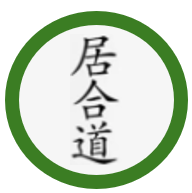11. JU-IPPON ME 十一本目
SOO GIRI 総切り
Complete cuts
While walking along you encounter a person in front of you who intends to attack you. Receive and parry their attack then make a diagonal cut to the left side of their face. Then continue cutting diagonally through their right shoulder to the solar plexus and then the left torso. Cut their abdomen across the waist horizontally from left to right and finally finish with a vertical downwards cut.
a] Take three steps forward beginning with your right foot. As your left foot steps forward take hold of the Tsuka with both hands. As your right foot moves forward partially draw the sword naturally forwards and slightly to your right front. Then bring the right foot back close to your left foot (as both feet move back) and parry the opponent's cut by bringing your sword above your head holding the Tsuka with your right hand. This Kamae has the same purpose as Ukenagashi. Immediately place your left hand on the Tsuka, step forward on the right foot using Okuri Ashi and make a diagonal cut to the left top side of the opponent's head down through to the chin.

b] Maintaining the same angle from the first cut, take the sword above the head. Step forward on the right foot using Okuri Ashi and cut the opponent through their right shoulder down to the solar plexus.
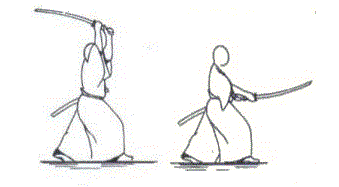
c] Maintain the same angle as before and take the sword above the head. Step forward with the right foot using Okuri Ashi and cut the opponent from the left upper chest down to the center of the navel. When you have finished cutting keep your sword horizontal.
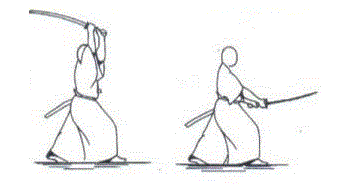
d] Keep the same angle as you raise the sword up over the head and bring it down and over to your left waist so that the blade edge is facing forwards. Hold il horizontally and without hesitation make a horizontal cut from left to right (180 degrees) whilst stepping forward on your right foot. Ensure this horizontal cut is made exactly horizontal and do not raise the hands.
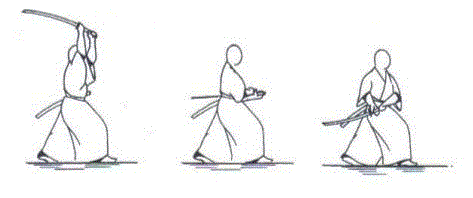
Special Note: When taking this posture, ensure the sword is held low enough at the left side whereby its angle is pointing naturally to the left rear. The characteristic of this cut is to move forwards and not just slash to the right.
e] Again without stopping bring the sword above the head and as your right foot steps forward using Okuri Ashi, make a downward vertical cut to the l10rizontal.
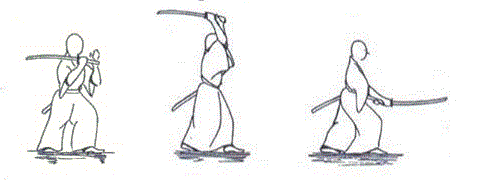
f] Without changing your posture move your left hand to the left side over the belt and do Migi Ni Hiraite No Chiburi (Yoko Chiburi) with your right hand.
g] Slide your left hand forwards from the belt to the Koiguchi and do Noto.
h] Bring your rear foot up in line with your front foot, release your right hand from the hilt and assume Taito Shisei. Return to the original starting position by stepping back commencing on your left foot.
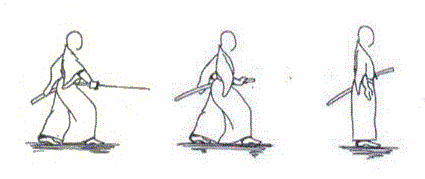
● There are two ways to begin this Kata, depending on the region of Japan where your Japanese Sensei is located.
West Side: Fully draw, then step back with your right foot, perform lateral Uke Nagashi, with the tip of the sword behind you... then continue.
East Side: Fully draw, then step back with your left foot and then your right, perform Uke Nagashi, positioning the sword identically to the third Kata.
● All cuts are made when the right foot stops. To prevent the left hand from straying off the central axis, the blade angle is very acute on all cuts.
● The Te no Uchi of both hands changes depending on the direction of the cuts. When preparing for the horizontal cut, the Te no Uchi will change slightly.
● For 6th and 7th Dan, it is important to advance the right foot while preparing for the 4th cut; this should be studied from the 4th Dan rank onwards.
● When moving forwards, does the performer use Okuri Ashi footwork?
● When making the horizontal cut, is it performed horizontally with the correct angle of the blade?
